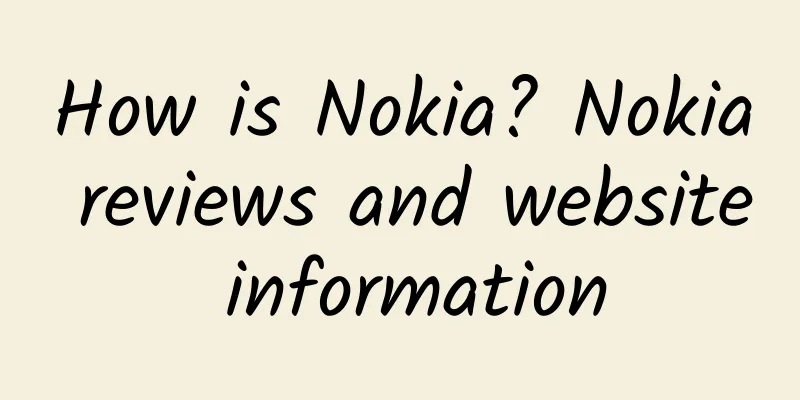How is Nokia? Nokia reviews and website information

|
What is Nokia? Nokia is a world-renowned mobile communication equipment manufacturer. It was founded in 1865 and is headquartered in Espoo, Finland. At the beginning, Nokia was mainly engaged in papermaking, and later involved in rubber shoes, tires, cables and other fields. Due to the advancement of communication technology, it finally developed into a mobile phone manufacturer. Since 1996, Nokia has occupied the first place in the mobile phone market share for 14 consecutive years; on September 3, 2013, Nokia's mobile phone business was acquired by Microsoft, and its business focus began to shift to Here map services. Website: www.nokia.com Nokia is a world-renowned mobile communication equipment manufacturer with a history that can be traced back to 1865. Headquartered in Espoo, Finland, Nokia started out as a paper manufacturer and then gradually expanded its business to include rubber shoes, tires, cables and other industries. With the rapid development of communication technology, Nokia eventually transformed into a company focused on the manufacture of mobile communication equipment, especially mobile phones. Since 1996, Nokia has occupied the top position in the global mobile phone market share for 14 consecutive years, becoming the dominant player in the mobile phone market at the time. However, with the advent of the smartphone era, Nokia's market position has gradually been challenged. On September 3, 2013, Nokia's mobile phone business was acquired by Microsoft, marking the end of its mobile phone manufacturing business. Since then, Nokia has shifted its business focus to the Here map service and continued to explore new development directions in the fields of communications and technology. Nokia's official website is www.nokia.com , where users can learn about Nokia's latest developments, product information and related technical support. Nokia is not only a company with a long history, but also an enterprise with significant influence in the field of global communication technology. Nokia's History and DevelopmentNokia's history dates back to 1865, when Finnish engineer Fredrik Idestam established a pulp mill in the town of Tampere in southern Finland. The mill produced pulp for papermaking, and then expanded into papermaking. In 1868, Idestam established a second mill in the town of Nokia, after which he named the company. The town of Nokia was named after the Nokia River that flows through the area, and the word "Nokia" means "sable" in Finnish. At the end of the 19th century, Nokia's business gradually expanded to include electricity, rubber and cables. In 1898, Finnish Rubber Works was established, mainly producing rubber products such as rubber shoes and tires. In 1912, Finnish Cable Works was established, focusing on the production of cables and wires. These three companies - Nokia Paper Mill, Finnish Rubber Works and Finnish Cable Works - merged in 1967 to form Nokia Corporation. In the 1960s, Nokia began to enter the electronics industry, producing televisions, computers and other electronic products. In the 1970s, Nokia further developed its electronics business and began to produce mobile communication equipment. In the 1980s, Nokia became the leading TV manufacturer in Europe, but its real rise was in the field of mobile communications. Nokia's mobile communications eraNokia's success in mobile communications began in the 1980s. In 1982, Nokia launched its first car phone, the Mobira Senator, followed by the Mobira Talkman, a portable car phone in 1984. In 1987, Nokia launched its first true mobile phone, the Mobira Cityman, which weighed about 800 grams and was considered a revolutionary product at the time, despite its large size. In 1992, Nokia launched its first GSM mobile phone, Nokia 1011, marking Nokia's official entry into the digital mobile communications era. Since then, Nokia has quickly become a leader in the global mobile phone market. In 1996, Nokia launched the Nokia 9000 Communicator, a smartphone with email and Internet functions, which is regarded as the prototype of modern smartphones. In the late 1990s and early 2000s, Nokia launched a number of classic mobile phones, such as Nokia 3310, Nokia 5110 and Nokia 8210. These phones have won the favor of users around the world for their durability, long battery life and simple and easy-to-use interface. Nokia's mobile phone business reached its peak in 2000, accounting for more than 40% of the global mobile phone market. Nokia's decline and transformationAlthough Nokia achieved great success in the era of feature phones, its market position was gradually challenged with the advent of the smartphone era. In 2007, Apple launched the iPhone, which completely changed the mobile phone market. The iPhone's touch screen design and rich application ecosystem quickly attracted a large number of users, while Nokia's response in the smartphone field was relatively slow. Nokia's attempts in the smartphone field include launching mobile phones based on the Symbian operating system, such as the Nokia N series and E series. However, the Symbian system cannot compete with iOS and Android in terms of user experience and application ecology. In 2011, Nokia reached a strategic cooperation with Microsoft and launched the Lumia series of mobile phones based on the Windows Phone operating system. Although the Lumia series of mobile phones have received certain praise for their design and technology, their market share has never met expectations. On September 3, 2013, Nokia announced that it would sell its mobile phone business to Microsoft for 5.44 billion euros, marking the end of Nokia's mobile phone business. Since then, Nokia has shifted its business focus to areas such as network equipment and map services. Nokia's Here Maps serviceAfter selling its mobile phone business, Nokia has focused on its Here map service. Here map is a digital map service launched by Nokia in 2007, originally named Ovi Maps. Here map provides global map data, navigation services and location-related application development tools. Here map data covers more than 200 countries and regions around the world, supporting multiple languages and multiple device platforms. The core advantage of Here Maps lies in its high-precision map data and powerful navigation functions. Here Maps not only provides traditional in-car navigation functions, but also supports navigation for multiple modes of travel, such as walking, cycling and public transportation. In addition, Here Maps also provides location service solutions for enterprises, helping them to better utilize location data in the mobile Internet era. Nokia sold its Here mapping business to a consortium of German automakers BMW, Audi and Daimler for 2.8 billion euros in 2015. Since then, Here mapping has continued to play an important role in areas such as automobiles, logistics and smart cities. Nokia's network equipment businessIn addition to map services, Nokia also focuses on network equipment business. Nokia's network equipment business mainly includes mobile network equipment, fixed network equipment and related software and services. Nokia's network equipment is widely used by telecom operators around the world to provide support for mobile communications, broadband access and enterprise networks. In 2016, Nokia completed the acquisition of Alcatel-Lucent, further enhancing its competitiveness in the network equipment market. Through this acquisition, Nokia acquired Alcatel-Lucent's technologies and patents in the fields of optical transmission, IP routing and wireless communications, which greatly increased its share in the network equipment market. Nokia's network equipment business has played an important role in the 5G era. As one of the world's leading 5G equipment suppliers, Nokia has provided 5G network equipment and technical support to telecom operators in many countries and regions around the world. Nokia's 5G technology not only has advantages in speed, latency and connection density, but also demonstrates strong innovation capabilities in emerging fields such as network slicing, edge computing and the Internet of Things. Nokia's innovation and futureAlthough Nokia's glory in the mobile phone market has become history, Nokia has not stopped its pace of innovation. In recent years, Nokia has actively explored new development directions in many fields, especially in communication technology, Internet of Things and smart cities. In terms of communication technology, Nokia is not only committed to the research and development and application of 5G technology, but also actively participates in the research of 6G technology. Nokia cooperates with many research institutions and companies around the world to promote the standardization and commercialization of 6G technology. Nokia's goal is to achieve a faster, smarter and more sustainable communication network through 6G technology. In the field of IoT, Nokia has launched a variety of IoT solutions, covering multiple application scenarios such as smart homes, smart factories, smart cities, etc. Nokia's IoT platform supports a variety of communication protocols and device types, and can provide users with efficient and secure IoT services. In the field of smart cities, Nokia helps city managers achieve intelligent management in areas such as transportation, energy, and public safety through its network equipment and technical support. Nokia's smart city solutions not only improve the efficiency of urban operations, but also improve the quality of life of residents. Nokia's Social Responsibility and Sustainable DevelopmentAs a global leading communications technology company, Nokia has always regarded social responsibility and sustainable development as one of its core values. Nokia has taken a series of measures in environmental protection, social responsibility and corporate governance to achieve sustainable development goals. In terms of environmental protection, Nokia reduces its impact on the environment by reducing energy consumption, lowering carbon emissions and promoting a circular economy. Nokia uses a variety of environmentally friendly materials and technologies in its product design and production process to ensure that its products have minimal impact on the environment throughout their life cycle. In terms of social responsibility, Nokia actively gives back to society through projects in the fields of education, health and community development. Nokia cooperates with many non-governmental organizations and educational institutions around the world to promote the popularization and application of digital technology and help more people enjoy the convenience and opportunities brought by digital technology. In terms of corporate governance, Nokia always adheres to the principles of transparency, fairness and responsibility to ensure that its business operations meet the highest ethical and legal standards. Nokia's board of directors and management fully consider the interests of all parties in the decision-making process to ensure the long-term sustainable development of the company. Nokia's future prospectsLooking ahead, Nokia will continue to play an important role in communication technology, the Internet of Things and smart cities. Nokia's goal is to promote the intelligence, efficiency and sustainable development of global communication networks through technological innovation and cooperation. Nokia will continue to invest heavily in 5G and 6G technologies to ensure its leading position in the global communications technology sector. Nokia will use 5G and 6G technologies to provide global users with faster, smarter and more reliable communications services. In the field of IoT and smart cities, Nokia will continue to launch innovative solutions to help enterprises and city managers achieve digital transformation. Nokia's IoT and smart city solutions will provide users with more efficient, safer and more sustainable services and promote the intelligent development of society. In conclusion, as a communications technology company with a long history, Nokia has not only achieved brilliant achievements in the past decades, but will also continue to play an important role in future technological changes. Nokia will continue to provide excellent communications technologies and services to global users through innovation and cooperation, and promote the intelligent, efficient and sustainable development of global communications networks. |
<<: How is GONZO? GONZO review and website information
>>: What are the Washington Nationals like? Washington Nationals reviews and website information
Recommend
How to choose dried sea cucumbers? Tips on how to choose dried sea cucumbers
Dried sea cucumber is a high-grade nutritional pr...
African thorn melon pictures and how to eat thorn melon
I wonder if you have never seen African kiwi melo...
How to cultivate hydroponic tiger lily
Hydroponic Sansevieria is a common green ornament...
How to make red bean and apple porridge
How much do you know about the recipe of red bean...
What is the NAACP like? NAACP reviews and website information
What is the website of the National Association fo...
How is the Mandarin Oriental San Francisco? Reviews and website information of the Mandarin Oriental San Francisco
What is the website of Mandarin Oriental San Franc...
The efficacy and function of sweet and sour water
Water is the source of life. People cannot live w...
How is "The Watt Bay Man"? "The Watt Bay Man" review and website information
What is Al-Watwan? Al-Watwan is the largest newspa...
The efficacy and function of litchi and the precautions for eating litchi
Midsummer is here, and it is the season for eatin...
What happens if you eat too many plums? Nutritional value analysis of plums
What will happen if you eat too many plums? I bel...
The efficacy, effects and contraindications of earrings Dendrobium
Earring Dendrobium is a kind of Chinese medicinal...
What should not be eaten with bamboo shoots? What is incompatible with bamboo shoots?
Bamboo shoots are a kind of fresh and tender spro...
How to deal with mangosteen shells? What are the benefits of drinking mangosteen shells soaked in water?
Some people have heard that mangosteen is not onl...
Benefits of Black Oatmeal
How many friends know the effects and functions o...
How to make Zexie porridge
The method of making Alisma orientalis porridge i...









